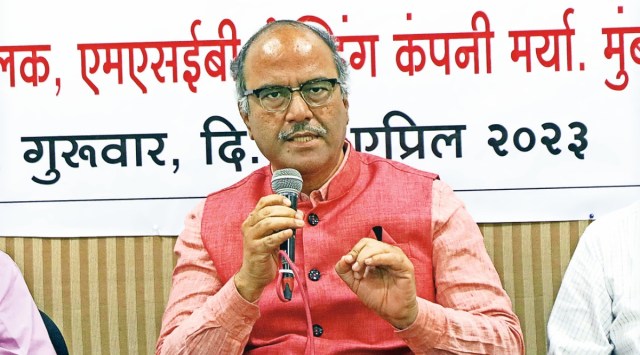Game changer: Under ‘Mission 2025’, farm pumps to run on solar energy
As per this scheme, by December 2025, at least 30 per cent of agricultural feeders in each district will be run on solar energy. This will provide electricity to farmers during the day.
 Vishwas Pathak at a press meet in Pune on Thursday.
Vishwas Pathak at a press meet in Pune on Thursday. THE state government’s ‘Mission 2025’ aims to run at least 30 per cent of agricultural feeders on solar energy by December 2025, which is aimed at transforming farmers’ lives, said independent director of MSEDCL and BJP state co-chief spokesperson Vishwas Pathak, at a press conference in Pune on Thursday.
He said Chief Minister Eknath Shinde and Deputy Chief Minister Devendra Fadnavis have decided to implement Mukhyamantri Saur Krishi Vahini Yojana – 2.0 (MSKVY 2.0). Mission 2025 will be completed under MSKVY 2.0, which was launched by Fadnavis on Monday.
As per this scheme, by December 2025, at least 30 per cent of agricultural feeders in each district will be run on solar energy. This will provide electricity to farmers during the day.
According to Pathak, this demand of farmers has been pending for several years. 45 lakh farmers have agriculture pumps in the state, and under this campaign, as much as 7,000 MW of solar electricity will be generated in the state and supplied to agricultural pumps, he said.
Towards this, the state will invest Rs 30,000 crore in the power generation sector.
“We anticipate a good response and several jobs will be created in rural areas,” he added.”Farmers will get an opportunity to earn an annual rent of Rs 1.25 lakh per hectare, by renting out land for solar power projects,” Pathak explained.
Officials said this scheme provides several benefits, such as support to agriculture sector, power supply to industries at fair rate, rural development and reduction in subsidy burden on state government.
Although electricity is currently being supplied for agri purposes at an average of Rs 1.5 per unit, MSEDCL gets it at an average of Rs 8.5 per unit. The tariff differential is covered by state government subsidies and cross subsidy burden levied on power tariff for industries, officials pointed out.
Since electricity obtained via solar energy will be available at around Rs. 3.30 per unit, the burden of cross subsidies on industries will be reduced in future, and electricity rates for industries and commercial users will be reduced, Pathak added.
Currently due to technical and economic reasons, electricity is supplied to agricultural pumps during the day and night.
Pathak admitted there has been a demand to reduce the burden of cross subsidy and supply power to industries at competitive rates. To solve this problem, MSKVY was launched in June 2017 during the tenure of then CM Devendra Fadnavis and Energy Minister Chandrashekhar Bawankule.
The scheme is being implemented by MSEDCL and so far, solar power generation projects of 553 MW capacity have been commissioned under the scheme and 230 agricultural feeders are supplying electricity to one lakh farmers for pumps during the day. On this background, it was decided to implement MSKVY 2.0, Pathak added.


































